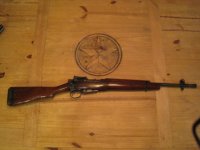Couple of things.But why bother? It's standard look is quite "sporty" without changing anything.
That horrible reduced width, hard as a rock "butt-pad".
A slightly higher comb for better cheek welds.
Now look at the Gibbs No7 & take a look at the sights. Horrible short open sight base (even shorter with the barrel bobbed). Why? because they were NOT made from No4's those are converted No1s of differing versions which is why I specified factory-made NO4 sporters, because of the massively better iron sights. The one illustrated is also in 7.62 (.308) so its not what he wanted , a .303 sporter, anyway.



